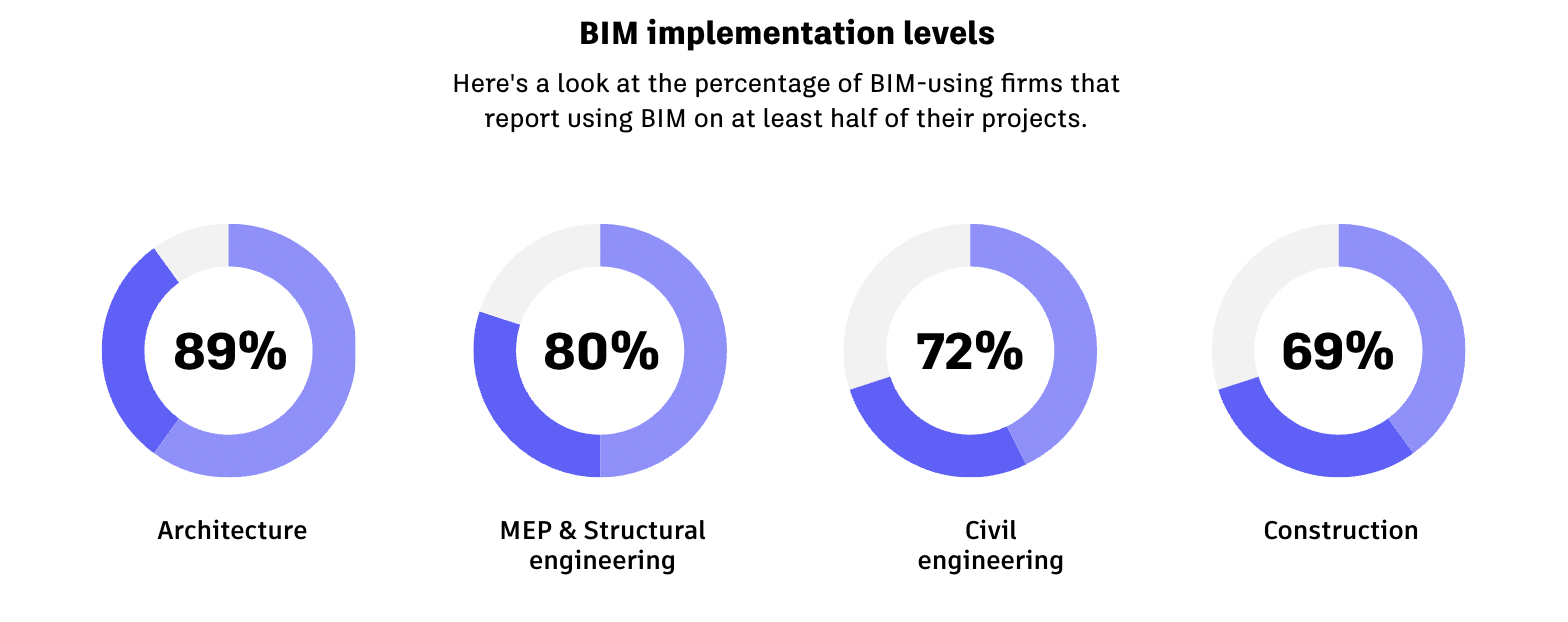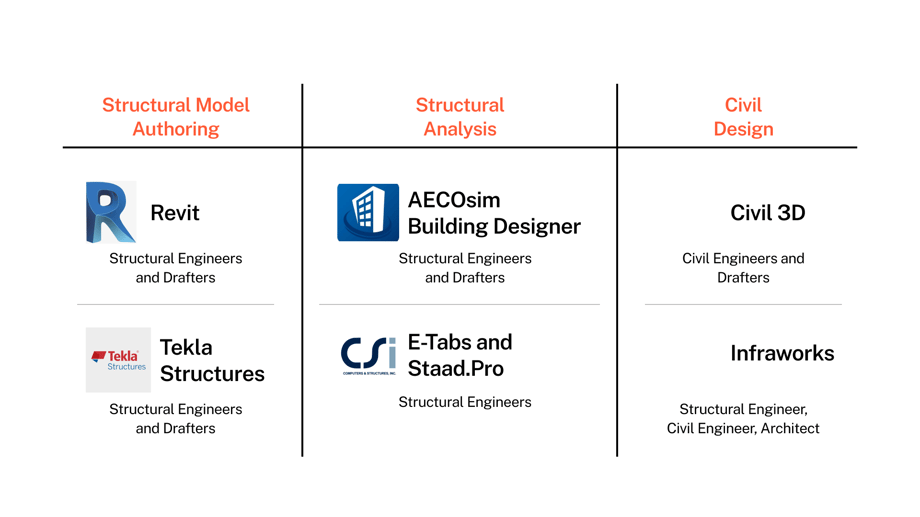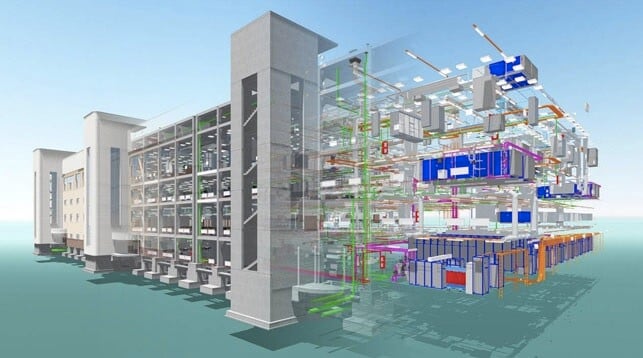Using BIM in Civil Engineering | Everything You Need to Know (2025)

Table of Contents
In this blog, we take a look at some of the most common questions about using BIM in civil engineering including its applications in the industry, its various benefits for civil engineers, popular BIM software for civil engineers, and even a list of BIM course suggestions to help you ace this new process. So let’s get started!
Content Guide
| 1. Introduction to BIM | 4. How does BIM benefit civil engineer’s careers? |
| 2. What are the applications of BIM in Civil Engineering? | 5. List of BIM course suggestions for civil engineers |
| 3. What are the popular BIM software used by civil engineers? |
1. Introduction to BIM
What is BIM?
BIM, or Building Information Modelling, is a highly collaborative process that helps digitally construct an accurate virtual model of a building known as a “building information model”. This model can be used for the planning, design, construction, and operation of the facility. It helps the various stakeholders visualise what is to be built in a simulated environment in order to help them identify any potential design, construction, or operational issues.
When completed, the building information model contains precise geometry and relevant data needed to support the design, procurement, fabrication, and construction activities required to realise the project. After completion, this detailed model can be used for operations and maintenance purposes as well
Advantages of BIM
There are various advantages of using BIM in the design and construction process, including:
1. Cost and resource savings: With BIM, AEC professionals can estimate costs related to materials, material shipping, and labour. Not only does this give architects a better idea about how much the project will cost, but it also helps them discover new ways to reduce costs early on. For example, they can choose more cost-effective materials, etc.
2. Shorter project lifecycle: Generally, the faster you complete a structure’s construction, the less money you will spend on the project.
3. Improve on-site collaboration and communication: The BIM ecosystem allows teams to share project models and coordinate planning. This ensures that all design stakeholders have detailed insight into the project.
4. Sustainability: BIM helps reduce construction waste and report carbon data. This helps in making the buildings and infrastructure projects more sustainable.
5. Transparency: There is an on-going debate that BIM might be the best way to fight corruption. BIM allows for greater transparency during the development stages, thus effectively reducing the likelihood of intentional design errors, false progress reports, and project estimation manipulations occurring.
Read more: 3 Best Ways to Learn and Benefit from BIM in Civil Engineering
Why is BIM important?
A recent report from Dodge Data & Analytics found that BIM is rapidly becoming a standard practice throughout the industry. While architecture firms are the fastest to adopt BIM practices, civil engineering firms are also embracing BIM at record levels.

The data above highlights the importance of BIM in civil engineering. The need to learn and understand BIM has never been more urgent in this rapidly digitising AEC industry.
2. What are the applications of BIM in Civil Engineering?

Civil engineering is a professional engineering discipline that deals with the design, construction, and maintenance of infrastructure projects such as roads, bridges, canals, dams, airports, sewage systems, pipelines, and railways. The misconception that many engineers have (because of the acronym “building” in BIM) is that BIM is only useful for architectural projects. But this is far from the truth. Civil engineers can, in fact, avail the benefits of BIM at all stages of an infrastructure project lifecycle. The following are some of the applications of BIM in civil engineering:
Capturing existing site conditions
BIM helps civil engineers start their projects more efficiently, by creating large-scale, intelligent 3D models of their project’s real-world environment. With BIM, they can easily aggregate large amounts of existing data, including reality capture data, 2D CAD, raster data, and GIS (Geographic Information System) data, to enhance the accuracy of the 3D model of existing sites.

Conceptualisation
Using an intelligent 3D project model, civil engineers can rapidly produce conceptual designs of their infrastructure and evaluate different options in preliminary design phases. This helps them transition to a detailed design stage faster by adding greater precision to their design model.
Detailed designing
BIM offers a range of tools for civil engineers for the process of detailed designing. They can use advanced tools such as component roads, cross-section views, and superelevation, for more advanced road design. For transportation projects, BIM tools can be used to effectively design roadway alignments and easily add turn lanes, intersections, and overpasses. Specialised analysis tools are used to check parking lot spacing and road styling to help determine lot counts for better preliminary subdivision layout concepts. BIM also facilitates better planning, design, and structural analysis of bridge structures with the help of expanded bridge design features like component-based bridges and line girder analysis to enhance accuracy and precision.
Performing analysis and simulations
One other use of BIM in civil engineering is that it helps perform analysis and simulations on the 3D models. BIM allows the engineering teams to make better design decisions with tools for sight distance, flood simulation, dynamic site analysis, and more. Some examples of this include:
- Modelling different types of intersections and roadway configurations, and simulating traffic at different times of day to find road optimal design alternatives
- More effectively determining if there is a need to widen roadways while increasing bridge clearances
- Providing for better stormwater management
- Incorporating light-rail corridors and connections
Coordination and collaboration
BIM helps all the stakeholders involved in a civil engineering project to collaborate on a shared model. This helps them stay engaged in the process, and contractors can use the model to create an informed bid while minimising cost surprises.
To know more about the applications of BIM in the field of civil engineering, as well as an insight into the whole process of using the process of BIM, check out our interview with Saniye, a BIM and Technology Coordinator at Prota Group in Turkey.
Cost Reduction
BIM can be used by civil engineers for model-based cost estimation or 5D BIM. BIM has tools to automate the cost estimation process early in the planning stage, helping save both time and expenses. This helps civil engineers calculate future expenses with much greater accuracy. These include anything from the costs of materials and prefabricated or modular elements to labor and shipping costs. Furthermore, BIM software can help companies optimise their expenses by comparing the cost-effectiveness of different materials, suggesting the best timing to purchase materials at a low market price.
Improved collaboration
Using BIM sets a project up for a controlled, direct data flow between office and field, and design and construction. BIM is a highly collaborative process that allows architects, engineers, real estate developers, contractors, manufacturers, and other construction professionals to plan, design, and construct a structure or building within a single 3D model.
Clash detection

Clash detection is a critical part of the integrated BIM modelling process. The process helps in speeding up projects by identifying clashes between several models during the design stage itself, helping civil engineers eliminate chances of multi-level design changes that can result in budget overshoot and delay of project completion time. Navisworks is the best BIM software in the market, useful for clash detection and clash report generation.
Improving sequencing and scheduling
4D construction sequencing combines 3D models with project programmes, creating an intelligent visual construction timeline. 4D construction sequencing is the best tool for on-site construction for civil engineers. Understanding the construction phase-by-phase timeline and schedule is made easier by this procedure. Better scheduling ultimately leads to better project delivery.
AR / VR
For civil engineers working on infrastructure projects, creating visualisations and walk-throughs with AR/VR can also impact the project delivery and how their current and potential clients perceive their ideas. This can also indirectly impact gaining more work or approvals.
After surveying 32 BIM-assisted projects, the Centre for Integrated Facilities Engineering (CIFE) at Stanford University found that the use of BIM technology resulted in:
- 80% decrease in the time required to generate an expenditure quote;
- Up to 40% reduction of unbudgeted project changes;
- Savings amounting to up to 10% of the contract value due to timely clash detections;
- Time savings of up to 7%; and
- Cost estimation accuracy within 3%.
Read more : What Kind of BIM Skills Companies are looking in Civil Engineers
3. What are the popular BIM software used by civil engineers?
BIM software for civil engineers provides a model-based process for designing and managing buildings and infrastructure, creating a digital representation of the functional characteristics of a facility beyond construction drawings. Some of the popular BIM software used by civil engineers include:
Revit
Autodesk Revit is a building information modelling software for architects, landscapers, structural engineers, mechanical, electrical and plumbing (MEP) engineers, designers, and contractors.
Tekla Structures
The software is used in the construction industry for details of steel and concrete, precast and in-situ casting. The software allows users to create and manage 3D architecture models in concrete or steel and guides them through the process.
Civil 3D
This is a comprehensive detailed design and documentation software for civil infrastructure. Created by Autodesk, it is used to plan, design and deliver land development, water and transportation projects.
Infraworks
InfraWorks is another Autodesk offering that helps civil engineers model and understand infrastructure projects in context. They use it to generate accurate and visually rich conceptual designs and aggregate contextual data from sources like geospatial information systems (GIS) and reality capture.
Navisworks
Used primarily in construction industries to complement 3D design packages (such as Revit, AutoCAD, and MicroStation) Autodesk Navisworks allows users to open and combine 3D models, navigate around them in real-time and review the model using a set of tools including comments, redlining, viewpoint, and measurements.
A selection of plug-ins enhances the package by adding interference detection, 4D time simulation, photorealistic rendering and PDF-like publishing.
Apart from software skills, an efficient civil engineer is expected to stay up-to-date with industry trends.
Also Read: What Are Civil Engineers Doing In 2025? Top 7 Emerging Trends in Civil Engineering
4. How does BIM benefit civil engineer’s careers?

Now you must be wondering – what are the monetary benefits of BIM for me? What are the job roles I can take up in BIM as a civil engineer? The change in construction industry dynamics worldwide has opened up a world of opportunities for civil engineers, specialising in the field of BIM.
Civil engineers are often dissatisfied with their professional lives. Low salaries and tiring visits to the site make them want to improve their careers somehow. BIM helps them to move from the construction part of the project life-cycle to the collaboration part of it. This shift, in turn, ensures them a better salary growth due to the skill's high demand as well!
Job roles
The broad careers in this field are :
Strategic BIM: BIM strategy is the organised blueprint for everything that concerns BIM in an organisation. As with BIM requirements, the nature of BIM strategy might vary heavily depending on the project's goal, among other things. Positions include client-facing roles, business development and legal.
Design BIM: These roles include the designers and the visionaries. Positions include initial design, project support and project communication.
Construction BIM: These are the positions for the people who are interested in the execution of tasks. Positions include estimators, on-site engineers and modellers.
Specific job roles have evolved from the much-in-demand BIM managers and BIM designers to include specialised positions such as structural BIM modellers, BIM modellers specific to Revit, BIM Technicians and Draughtsman (MEP), BIM software developer, BIM consultants, BIM trainers, BIM civil designer, BIM coordinator civil 3D, BIM 3D civil drafter, civil faculty, civil structural design engineer, BIM sales manager, and so on.
Remuneration
Did you know that BIM-skilled engineers earn 40% higher than the industry average? This is because BIM skills are high in demand and low in supply.
Read more: Graduates from Oneistox’s BIM Professional Course (Cohort - 1) Land Placements at Coveted AEC Firms

Let us look at the numbers to back this up. According to industry information aggregators such as www.talent.com, the average bim engineer salary in the USA is $85,000 per year or $43.59 per hour. Entry-level positions start at $67,500 per year while most experienced workers make up to $125,000 per year. This accounts for a huge salary hike from the meagre salaries between $65,895 and $79,411 that civil engineers used to make earlier. (According to www.salary.com)
According to industry information aggregators such as PayScale and Crisal, a career in BIM in India for Civil Engineers can fetch a salary in the range of ₹4 to ₹19 lakhs, depending on expertise and experience. Going forward, a civil engineer can position his/her career at the forefront of the construction industry if he/she is well acquainted with the evolving demands of the industry.
According to Glassdoor, the average salary for a Bim Engineer is £37079 per year in the United Kingdom.
Read more : What is BIM for Civil & Structural Engineers
5. List of BIM course suggestions for civil engineers
Now that we have established the relevance and importance of BIM for civil engineers, let us look at some BIM course suggestions for civil engineers to get you started.
1. Novatr
Mode: Online, part time
Completion time: 6 months
Novatr offers a one-of-a-kind BIM Professional Course for civil engineers that features a specialised career-relevant curriculum designed and delivered by BIM experts from leading firms. The 6-month offering involves online part-time study and equips learners with a holistic understanding of BIM processes and software knowledge spanning modelling, information management, cloud collaboration, presentation, clash detection, and visual programming. The course allows you to learn from AEC professionals leading BIM at top-tier firms worldwide and work on a live, RIBA-structured capstone project to practice your skills.
Placements: Architects and civil engineers, upon upskilling in BIM tools and processes with Oneistox, have witnessed an average pay hike of 60%. In Oneistox’s first BIM cohort itself, 80% of the eligible candidates have been placed at some of the most coveted MNCs in the AEC industry. Among Oneistox’s BIM graduates, early-stage professionals landed an average salary of INR 5.5 LPA while mid-senior level professionals received an average salary of INR 7.6 LPA. Companies where students have secured placements include: Techture, DAR, The BIM Engineers, TATA Consulting Engineers, Colliers, Total Environment, among others.
2. Skill Lync
Mode: Online
Completion time: 8 to 12 months
The ‘Drafting and Design using Revit’ course offered by Skill-Lync provides BIM training on both parametric design skills and drafting standards to create error-free drawings. The website suggests that the course is suitable for students of civil engineering in the first, second, third, or final year, as well as employees in civil engineering firms who are looking to upscale in their profession.
3. BIM Labs
Mode: Offline
Completion Time: 240 hours - 850 hours
BIMLabs offer aspiring professionals a platform and the tools to efficiently plan, design, construct, and manage buildings and infrastructure. They have an offline training centre in Kerala. BIMLabs also offers placement opportunities after the completion of the course.
4. TechnoStruct Academy
Mode: Online and E-Live Classes, Classroom training in Hyderabad and New Delhi
Completion Time: 8 months (for the BIM-ready+ course)
TechnoStruct Academy provides online training courses to prepare in the field of BIM, AutoCAD, Revit, and NavisWorks. TSA is the training division of the US-based Engineering & Technology BIM firm called TechnoStruct LLC.
I hope this blog gave you the insight you needed to accelerate your career in the Architecture, Engineering, and Construction (AEC) Industry by helping you learn the relevance of BIM in Civil Engineering.
Interested to learn more about BIM and its career opportunities? Go to our Resources page to find more insights on these topics and more.

 Thanks for connecting!
Thanks for connecting!

.png)
.png?width=720&height=158&name=BIM-C%20A%20(Course%20Banner).png)
.png)



.jpg)


